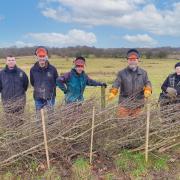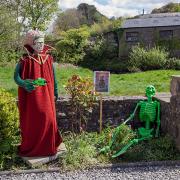Glynn Ward takes us on a photographic journey around one of Lancashire's most fascinating haunts
The ribcages of rotting hulks poke through the grey silt like so many bones in a dinosaur’s graveyard.
Boats that haven’t felt the salt spray of seawater for a generation sit high, dry and incongruous on the grassy marshland, slowly disintegrating. More modern steel-hulled vessels rust gently in hues of vivid red and orange.
Some are connected to home-made jetties that wouldn’t look out of place in a Third World shanty town. This stark landscape could be from a Dickens novel. All that’s missing is the prison ship, the eerie churchyard and a runaway convict or two. Skippool Creek might not be the most beautiful place in Lancashire at this time of year but its stark bleakness makes it one of the most interesting.
It’s also one of the most photogenic. Lancashire Life freelance photographer Glynn Ward stumbled across the River Wyre creek during a trip out on his bike. He couldn’t resist going back with his Nikon.
‘Many of the boats look like they have just been forgotten by their owners. They seem abandoned, stranded on the marshes,’ he said. ‘You see the odd person tinkering with a boat but there are few signs of life.
‘It’s just a crazy jumble – the place is a photographer’s dream, especially if the light is right. When I arrived it had been raining and the sky was black and blue. But while the sky behind the boats was dark, shafts of light were coming over my shoulder, illuminating the scene.’
Someone once described Skippool Creek as resembling a bend in the Mississippi and it certainly has that feel. There have been signs of human habitation here going back 12,000 years but the first real settlement is thought to have been by the Saxons with the name coming from their word for skiffs used to navigate the river.
It wasn’t until the 17th Century that it rose to prominence as the Wyre’s main port, in the process making the fortune of the nearby market town of Poulton-le-Fylde.
Records dating back to 1600 show brothers James and William Blackburne, of Thistleton, trading in flax and tallow with Russian merchants who discharged their cargoes at Skippool.
The influx of sailors inevitably turned it into a colourful area. It became known as a centre for cockfighting, smuggling, ale houses, famously strong drink, prostitution and press gangs. Rumours remain of tunnels under the river.
Substantial sailing vessels from around the world would head up the Wyre to unload flax and cotton for the Lancashire mills and guano from Africa while ships from the West Indies would bring rum, sugar and tobacco.
There is some debate but no firm evidence of Skippool and nearby Wardleys having been used for slavery.
Its success was such that in the 1750s shipping activity at Skippool and Wardleys, on the other side of the Wyre, exceeded the Port of Liverpool.Industrial progress in the form of the railway meant that when the train line arrived in Fleetwood in 1840 it sparked the construction of new harbours which could accommodate much larger vessels.
This led to Skippool’s slow but inevitable decline as a major port. Today, the last vestiges of its maritime past can be found in the shape of David Moss Boatbuilders, which has been creating and restoring traditional wooden sailing vessels since the 1970s, and the Blackpool and Fleetwood Yacht Club, home to vessels rather more shipshape. It is on the site of an old bone mill, once producing powder for farms and lead-smelting around the world.
There is also The River House, now a private residence built in the 1830s but once a famous restaurant frequented by the likes of Rudolf Nureyev, George Harrison and prominent politicians.
One less serious echo of its heyday can be found at Blackpool Tower Dungeon attraction which has a section devoted to ‘Skippool Smugglers’ where fact meets more fantasy, no doubt.
March around the marsh
One of the more famous boats crumbling at Skippool is the MV Good Hope, which is believed to have been built in the 1830s.
No one is 100 per cent certain this is the same boat.
You can see for yourself by following our man Keith Carter’s walk around Skippool. You can find it by going to www.lancashirelife.co.uk and looking in the Out and About section. There is a carpark at the Wyre Estuary Country Park.



























